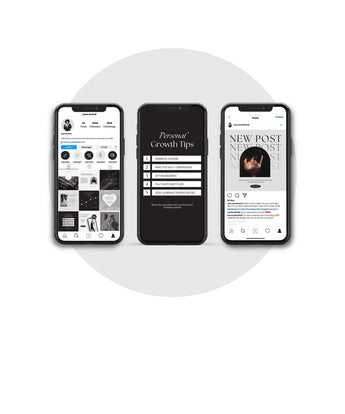Branding a business on social media is one of the most challenging tasks you can undertake. But when done well, it can set you apart from the crowd and help you connect with your target audience.
Social media branding is all about building a strong reputation and trustworthiness among your audience. Whether you’re selling products or services, or you’re building your brand online, you need to build your audience so that when they are ready to buy from you, they already know and trust you.
In this guide, we’ll go over the 10 main components to social media branding that will help you connect and build rapport with your audience. We’ll look at the best ways to brand yourself online by using the right visuals, targeting the right audiences, and creating content that your audience will respond to.
With these ten components in mind, you’ll be able to create social media content and ads that are tailored to your specific audience—and ultimately develop the kind of brand image that people will trust and respond to. So let’s get started!
How should you brand your business on social media?
1. The Basics of Social Media Branding

In the world of social media, social media branding is the practice of identifying the unique characteristics of your business and creating content that is designed to build awareness of those unique characteristics. Social media branding includes the creation of logos, covers, social media profiles, and any other online media material you create.
You must have a social media presence if you want to attract people and drive traffic to your website. You don’t want users to see your profile or brand and think, “oh that’s not my kind of thing.” This is true for any company, but especially for those that deal with consumers.
Viewers can decide in seconds whether or not they like you based on what they’ve seen on social media. And the bottom line is that if they don’t like you, you lose. That’s why it is so crucial to have a well-designed social media branding strategy.
One of the most important aspects of social media branding is ensuring that you have a profile photo that is unique and that really represents your brand. Usually, it should be a clean photo with your logo, so people can easily identify your brand page.
Remember that profile pictures are an opportunity to show off the personality and character of your business and it can differentiate yourself from other brands.
Once you’ve developed a profile picture that you like, it is time to develop your cover photo that will represent your brand’s personality on social media.
The cover photo is the most visited section of a social media page. Therefore, your cover photo must be compelling. It should stand out from the crowd by showcasing your brand’s personality. Remember, you only get one chance to make a good impression on visitors, and social media platforms like Facebook, Pinterest and Linkedin offer a great space on your profile to showcase a cover with a call-to-action message.
Make sure these are the first things you do when developing a branding strategy.
2. The Importance of Visual Assets
We all have to work to make our brands memorable. But if we want to get noticed and remembered for good, we need to create visual assets that set us apart on social media.
Visual assets aren’t just a nice-to-have. They’re essential for generating engagement and building trust. Research shows that visual assets are among the most effective ways to grab the attention of social media users, especially in comparison to longer forms of content.
Think about your business, and decide what kind of visual assets you can use to build your brand. Can you use photos? Can you use infographics? Can you use videos? There are so many different kinds of visual assets that you can use to attract customers. A few examples of visual assets include:
- Photo Posts/Stories
- Infographic Posts
- Videos
- Carousel Posts
- Covers/Banners
- Meme Posts/Articles
You should try to make sure that you use these kinds of assets in your branding strategy. Your brand is your business. Without visuals, no one would be interested in your products or services. So, it is important to make sure that you use all the tools the social media platforms offer and post different types of visual materials. It will help to keep your followers engaged and increase your brand's trust.
3. What Makes a Good Brand Voice?

Think about your brand as having a personality. The personality of a brand is a feeling and emotional response people get when they interact with a brand. There are two parts to creating a brand voice: establishing a personality and giving a brand personality a voice.
When it comes to establishing a personality, you need to identify traits that are consistent across all communication channels. Then, when you talk about a brand, think about how those traits will appear in your writing, graphics, and voice.
The purpose of a brand voice is to differentiate your brand from all other brands. So, here are three main things to consider in developing a brand voice:
- Tone – Your brand voice should convey a feeling that makes people feel certain emotions. For example, “Pizza Pizza” conveys a feeling of comfort, while “Casa Grande” conveys a feeling of excitement.
- Clarity – Your brand voice must be clear and precise. Don’t make your brand voice too vague or confusing.
- Focus – Your brand voice should focus on your company’s core competencies. Don’t make your brand voice too generic or too specific.
In addition to the three main components of your brand voice, there are also three other important aspects that go along with developing a branding strategy:
- A brand’s personality
- Audience needs and wants
- Value proposition
4. Use Content Marketing as a Brand Differentiator

Content marketing is a popular strategy for growing an online presence. It can be used to connect with customers, build an audience, increase engagement, and generate leads.
Using content marketing as a branding strategy works best when you have insight into who your audience is and what they want. This allows you to build trust with them, provide useful and interesting information that speaks directly to them, and establish yourself as an authority figure.
A company can really take off with the help of content marketing. To achieve success, you need to find out what type of content clients are interested in and what makes them engage with it. People will be willing to share your content if it is good and especially, when it offers them value. The more you understand about your audience, the better chance you have of providing them with useful and relevant information.
You should use all the tools available to you to produce and promote your content. For example, you can start a blog and post informative and helpful materials. You can share it on social media sites with the help of social media templates. You can also make a TikTok video with a few tips from the article. Your followers will appreciate this and share it with others. This can result in more visits to your website since the viewers will want to read the full article.
5. Understand the Different Types of Social Media

Are you struggling to understand the difference between the types of social media networks and the purpose of each one?
In this day and age, social media marketing is a key part of almost any marketing plan. If you don't understand it, you will have problems with it. Social media is a way to connect with people and allow them to see what you have to offer. It's also a way to spread news and information about your company and build your brand.
You can use the social medium to engage users, drive sales, or use it to provide support and information. So, it really is a crucial part of any marketing plan.
What are the different types of social media? There are three main types of social media:
- Personal
- Professional
- Community
You will find that each type has its own purpose and that using them together is ideal. But, first, let's take a closer look at the three main types of social media:
Personal
Professional
- Google Plus
- Quora
- Blog
Community
- Tumblr
- TikTok
- Quora
- Blog
Once we realize that these social networks exist for a specific purpose, it makes it easier to navigate and make good use of them. This can only result in higher engagement and an increase in sales for your company.
6. Make the Most of All Types of Social Media

How can you make sure that your social media strategy is working for your brand? You can start by ensuring that you are on all of the social media channels that your target audience is using. After that, there are several things you can do to make sure your social media presence is helping your business and branding goals.
Social media marketing is often misunderstood, and it is easy to think that your content is working if your audience is liking or sharing it. This can be a very short-sighted view of the market.
While liking and sharing your content is a critical first step, there are several more actions you can take to ensure that you are engaging your audience.
The first step you need to take is to figure out the type of content your audience is interested in. You can start by looking at which posts generate the most engagement. Once you understand what works, you can then start producing that type of content.
There are lots of different types of social media content. You can create posts or stories for Facebook and Instagram, pins for Pinterest or short engaging texts for Twitter. In addition, you can make videos for TikTok and then re-purpose them on other channels as reels or pins. This is what agencies call 'content recycling' and it comes in handy especially when you want to be present on multiple social media channels.
There is nothing wrong on growing multiple social media accounts as long as you keep a seamless brand image across all of them. This can easily be done with our ready-made template packs.
7. Add Value to Your Social Media Content

Social media branding done right is not about creating posts to simply drive awareness or traffic to your social channels. Instead, it’s about giving your audience what they want so they will gladly engage and share your content.
In order to do this, you need to establish yourself as an expert in your industry and demonstrate real value to your followers.
To add value to your social media content, you must first understand your audience. The reason you want to be able to do that is because you want to develop a more personal connection with your potential clients. Once you have a good understanding of who you are speaking to, you will want to create a message that will resonate with them, and that message will likely include something of value.
There are many ways to add value to your content. One thing that you should remember is that you don't need to reinvent the wheel. There are a lot of companies that provide great content that you can use to inform your audience. Always check out what others are doing and use the same approach to your content to increase its value.
Another good tip to follow is to write about what you know related to your industry. You can easily write an article or make a reel explaining a 'hack' that could help your viewers. This way, you are building trust and providing helpful information all while looking like a real expert from your industry.
Businesses underestimate the power of high value content and how easy it is to build a successful brand image across all social media platforms. All you need to do is actually help individuals for free with the use of posts, stories, articles and videos.
8. Set Yourself Apart from Your Competitors

Don’t forget the competition! By setting yourself apart from competitors, you’re not only creating a unique selling proposition (USP), but you’re also making it easier for your customers to understand why they should choose you over your competitors.
In order to create a unique selling proposition (USP), you should know how you stand out in the market. For example, you should ask yourself what is the most distinguishing characteristic of your company? Then, you should find out how you can capitalize on that characteristic to differentiate yourself from your competitors. Your business will not stand out if your competitors are providing a service that your target audience really wants.
With that in mind, let’s take a look at a few ways that you can set yourself apart from your competitors:
By delivering a truly unique experienceYou can do this by creating a brand identity and culture that’s aligned with your target audience’s values, needs, and desires. This can be accomplished by designing and creating a brand that’s aligned with your unique position in the marketplace.
You can also do this by creating a brand that provides a truly innovative solution to a common problem that your target audience faces.
By making a stronger connection to your audienceYour ability to connect with your audience will help you build rapport and develop trust with them. Once you have that trust, then you can establish a deeper relationship and grow that into a long-term customer relationship.
If you want to create a lasting impression, then you should listen more than talk. You must show that you care about your audience by listening to them. By doing this, you will be able to understand your customers' concerns and help them solve those problems.
By using authentic contentYour content should be engaging and entertaining. To create authentic materials, you should be authentic yourself. Authentic content will help you to build rapport with your audience. As a result, your audience will feel more comfortable sharing your brand with others.
By building a loyal audienceThe more loyal your audience is to you, the more likely they will be to share your brand with their friends or talk about your product or services. A long-term marketing strategy relies on building customer loyalty since this is the key to constant and recurring sales.
If you build this loyalty with your customers, you will not only be able to generate a constant stream of cash-flow for your business, but you will also have not fear when it comes to your competition.
9. Develop an Online Community

Once your product launches, it's essential to create a community around it and encourage people to be part of it. Those who are invested in your product can be more likely to spread the word about your offering and more willing to help answer questions or address any challenges you may encounter. So, whether it's an online forum, a group of experts on Facebook or Twitter, your product's success depends on the community you've built around it.
You need to find ways to get the conversation going. The best way to do this is through informational materials, either written, photo or video. But don't just write content and call it a day. You must actively engage in the community. You should be posting frequently, answering questions, commenting and generally being as active as possible.
There's also the matter of creating the kind of content that is going to connect with your users. For example, if you're launching a fitness app, you're going to need to have the kinds of videos and posts that help people feel motivated to use your product. On the other hand, if you're launching a dog grooming service, you need to produce content that will show potential clients that you know how to treat dogs and actually care for them.
10. Be Creative and Stay Inspired

Let’s face it. Marketing and branding are creative endeavors. It requires time and effort to get to the end goal of converting prospects into paying customers. So when you come across a piece of content or a video that inspires you, let’s be honest, it gives you a rush of energy and adrenaline. You think, “I’ve got to create something like this, too!”
When creating content for your business website, a good place to start is to begin brainstorming ideas for the kinds of topics that will inspire you to write. Ask yourself these questions:
- What's the best advice I can give to my community members?
- What's the most exciting thing I learned recently and can share with others?
- What is my favorite thing about my niche?
- Why would someone want to buy my product or service?
- How can I offer them the best value?
- What is the reason why they are going to use my product?
In conclusion, for many small business owners, there’s no denying that social media has changed the game. It’s made it much easier for people to interact with your brand and this makes the branding of your company so important. You need to have a seamless social media brand identity across all social media networks. The only problem is that a lot of social media marketers are confused about exactly what that means and whether they’re creating the right brand identity for their social media campaigns.
If you are also struggling with your social media branding, especially the design part, you can check out our social media bundles. They include everything you need to create a seamless brand image across multiple social media platforms!

















